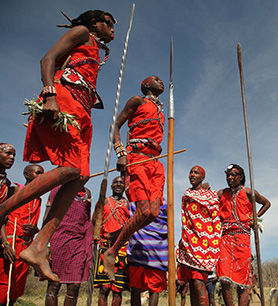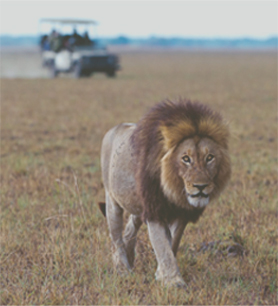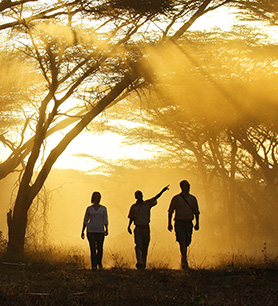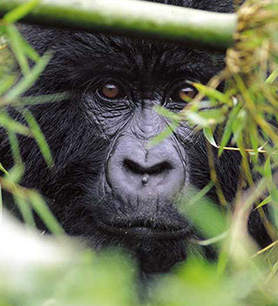The great wildebeest migration takes place invariably every year, but like any natural phenomenon is unpredictable. However the rains distribution in the Serengeti-Mara, on which the movements of the herds depends, follows rather constant trends during the year. To witness this show it is essential to be in the right place at the right time. Below we tell you about the migration route month by month.
January – March: the new generation
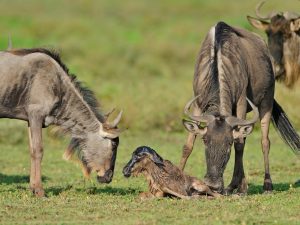 At this time of year the wildebeest herds are mostly sedentary and crowd the Southern plains of Serengeti National Park and the Ndutu Lake area, in the Ngorongoro Conservation Area.
At this time of year the wildebeest herds are mostly sedentary and crowd the Southern plains of Serengeti National Park and the Ndutu Lake area, in the Ngorongoro Conservation Area.
In January the migration reaches the extreme south of the Serengeti and the Ndutu area, which is located south-east of the park. Hundreds of thousands of wildebeests, zebras, Thomson’s gazelles, eland and other antelope species gather here dotting the plains as far as the eye can see.
The fertile soil of volcanic origin, bathed by the “small rains” fallen in November and December, is covered with short fresh grass, rich in calcium and other nutrients ideal for nursing females and their young.
This is actually the calving season. In about two months, between February and March, after a gestation of 8-8,5 months, the female wildebeest give birth to about 400,000 young. Most of the births are concentrated in February in a window of about 3 weeks, during which an average of 8,000 wildebeests a day are born.
It is one of the largest parts of mass birthing on the planet. Such an overabundance of births, synchronized in such a short period of time, reduces the impact of losses due to predators and other natural causes, ensuring the survival of the new generation of wildebeest.
The births generally take place in the early morning hours to allow the newborn, which in a few minutes is already standing up, to strengthen and learn to run before nightfall. Within 2-3 days the young are already able to keep up with the herd.
The wildebeest herds, filled with thousands of young, stop in the plains of Southern Serengeti until water and food abound.
If you are interested in observing the large herds of wildebeest, the birth of the young and the interactions with predators, this is the best time to travel. Our favourite accommodation in the Southern Serengeti and the Ndutu area are the Legendary Migrational Camps, Olakira Migration Camp and Serengeti Safari Camp, all of which are mobile tented camps.
April – May: the journey (re)starts
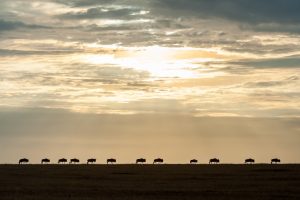 In April the pastures in Southern Serengeti, impoverished by months of drought and grazing, are no longer able to support the wildebeest herds. The “great rains” begin, which last until May and push the migration northwards. It is time to (re)start the journey.
In April the pastures in Southern Serengeti, impoverished by months of drought and grazing, are no longer able to support the wildebeest herds. The “great rains” begin, which last until May and push the migration northwards. It is time to (re)start the journey.
A transition period begins during which the migration moves northwards and westwards, where the rains have revived the pastures and food is abundant.
As a general rule, the herds become more concentrated when the weather is drier and not favorable, from January to March and from July to October, while they disperse when there is abundance of food, as in this period.
The migration is fragmented into endless columns of animals, even tens of kilometres long, which proceed slowly towards the Seronera area, in the Central Serengeti, and from here towards the Western Corridor and the Grumeti River.
Towards the end of May the wildebeest gather in the Western Serengeti, south of the Grumeti River, where they tend to form a mega-herd again.
At this time of the year we recommend you staying at Dunia Camp, in the Seronera area, in the center of the Serengeti.
June: the mating and the Grumeti River
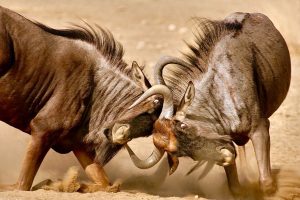 The migration faces the first major obstacle in its journey to the north: the Grumeti River.
The migration faces the first major obstacle in its journey to the north: the Grumeti River.
The Grumeti is a perennial river that flows in an east-west direction at the Western end of the Serengeti and, together with the Mbalageti River, marks the Western Corridor, a valley about 50 km long that extends almost as far as Lake Victoria.
This remote corner of the Serengeti features different habitats and the landscape changes. Here the grassy plains, typical of the south of the park, are interspersed with flood plains, forested hills and valleys crossed by seasonal rivers.
June is the mating season. The wildebeest males, full of testosterone, fight to enlarge their provisional territories and include as many females as possible. As with calving, mating is synchronized: over 500,000 females mate in a period of about 4 weeks.
Crossing the Grumeti River can be fatal for herds, especially in years of heavy rain. Exhausted for the long journey and mating, many wildebeest drown where the water is deeper and many others succumb in the jaws of crocodiles.
At this time of the year the distribution of rains has a strong impact on the migration and the herds may separate to follow different routes.
If you want to travel in June, to increase your chances of intercepting the migration we suggest a combination of two camps located in different areas, for example Ubuntu Migration Camp or Serengeti Safari Camp and Singita Faru Faru Lodge, located right on the banks of the Grumeti River.
July – August – September: the Mara River crossing
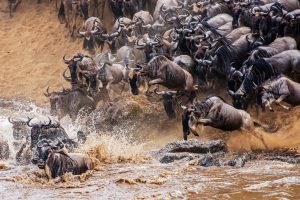 In July, when the plains of Central and Western Serengeti are now dry, the herds move north-east in search of fresh pastures.
In July, when the plains of Central and Western Serengeti are now dry, the herds move north-east in search of fresh pastures.
The time when the migration reaches the north of Serengeti always depends on the climatic conditions and the distribution of rainfall during the year.
When water and food are abundant, the herds can linger in the Seronera area and in the Western Corridor and reach the north later, in early August. If the conditions are not favorable, the first wildebeest reach the Northern pastures and the Mara River at the end of June or early July.
The Mara River rises on the Kenya highlands and flows for about 400 km to Lake Victoria, across the Kenya-Tanzania border. The river flows for about 65% in Kenya, where it crosses the Maasai Mara National Reserve, and for about 35% in Tanzania, partially within the Serengeti.
The Mara crossing is one of the hardest challenges that the wildebeest have to face during their long journey, and it is considered by many as the pinnacle of the great migration.
This is not a single event, but there are multiple crossings of herds ranging in size from a few tens to thousands. The herds zigzag and cross the Mara River in both directions, from south to north and viceversa, at any time from July to late October.
On the Mara River, straddling the border between Tanzania and Kenya, there are about twenty crossing points regularly used by the herds to cross the river.
The wildebeest gather on the banks of the Mara, where they can linger for hours, waiting for the first individual to take the initiative and decide to cross. It is the fuse that triggers the crossing of the rest of the herd: ten, a hundred, a thousand, ten thousand wildebeest follow the first brave one wrapped in a cloud of dust. The most numerous crossings can last over an hour.
The Mara is a river with a higher flow and stronger currents than the Grumeti and, like and more than the latter, is infested with hungry crocodiles. Every year thousands of wildebeests drown in the river, because they are injured or too weak to overcome the current, and fall victim to crocodiles.
Those who succeed in crossing the river continue their journey to the plains of the Maasai Mara and bordering concessions, where the herds stop until October. However, it is not uncommon for the herds to retrace their steps, crossing the Mara again in a southerly direction, or not to cross at all and remain in the Kogatende and Lamai Wedge areas in the north of Serengeti.
If you are interested in seeing the spectacular Mara River crossings, we recommend that you travel in August and stay in one of the camps along the river, or nearby, in Tanzania or Kenya. Our favourite accommodations are Lamai Serengeti and Sayari Camp, as well as the mobile camps in the Northern Serengeti, and Mara Plains Camp and Rekero Camp in the Maasai Mara.
October: apparent calm
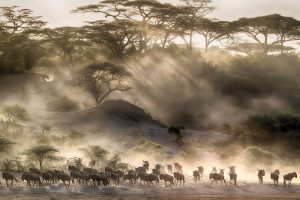 Waiting to resume their journey south, the wildebeests continue to graze in large herds between the Maasai Mara in Kenya and the northern Serengeti in Tanzania.
Waiting to resume their journey south, the wildebeests continue to graze in large herds between the Maasai Mara in Kenya and the northern Serengeti in Tanzania.
From June to September, during the dry season, the rainfall in Kenya and Tanzania is sporadic or completely absent, and always very localized. The plains of the Maasai Mara and Northern Serengeti, burnt by the sun and now exhausted, are desperately in need of water.
As in April, the pastures are no longer able to support the wildebeest herds that, anticipating the rains, begin to move eastward through the Maasai Mara and back south into the Serengeti. During this period the crossings of the Mara River are still frequent.
When the rains start, at the end of October, the first herds begin their journey back to the plains of Southern Serengeti, moving along the Eastern border of the park and through the Loliondo area.
In October the best areas to observe the great migration are the south-east of the Maasai Mara and the north-east of the Serengeti. Our favourite accommodations are Cottar’s 1920 Camp or Sala’s Camp in the Maasai Mara and Serengeti Migration Camp or Klein’s Camp in the Serengeti.
November – December: way home
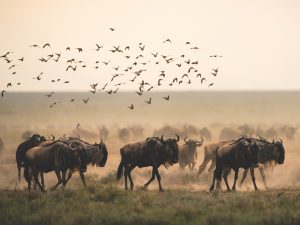 November is another unpredictable month, during which the wildebeest herds can be already in the Southern Serengeti and the Ndutu area or linger in the north for most of the month. During their journey southwards the herds often separate and move with different pace and routes, but by the end of December most of them will have reached the south of the park.
November is another unpredictable month, during which the wildebeest herds can be already in the Southern Serengeti and the Ndutu area or linger in the north for most of the month. During their journey southwards the herds often separate and move with different pace and routes, but by the end of December most of them will have reached the south of the park.
The wildebeest are back home again, in those plains where only 6 months before they have started their journey. Thousands invade the Southern Serengeti and Ndutu, taking advantage of the shoots and fresh grass brought by the rains.
During this period more than 90% of wildebeest females are pregnant and are preparing to give birth. The cycle of life continues and another great migration, filled with a new generation of young wildebeest, will soon resume its long journey north.
If you want to travel in December, we recommend staying in one of the mobile tented camps in the Southern Serengeti or in the Ndutu area, while in November, to increase the chances of intercepting the migration, we suggest you to combine Lamai Serengeti, Sayari Camp or one of the mobile tended camps in the north with Dunia Camp or Namiri Plains Camp, located in the Central-Eastern part of the park.
The great wildebeest migration is one of the most fascinating and extraordinary natural spectacles on the planet. To witness this epic journey between life and death, to see these great big herds grazing on endless plains or crossing rivers in a bedlam of mooing and dust is a privilege, a moving experience, to be lived at least once in a lifetime.




